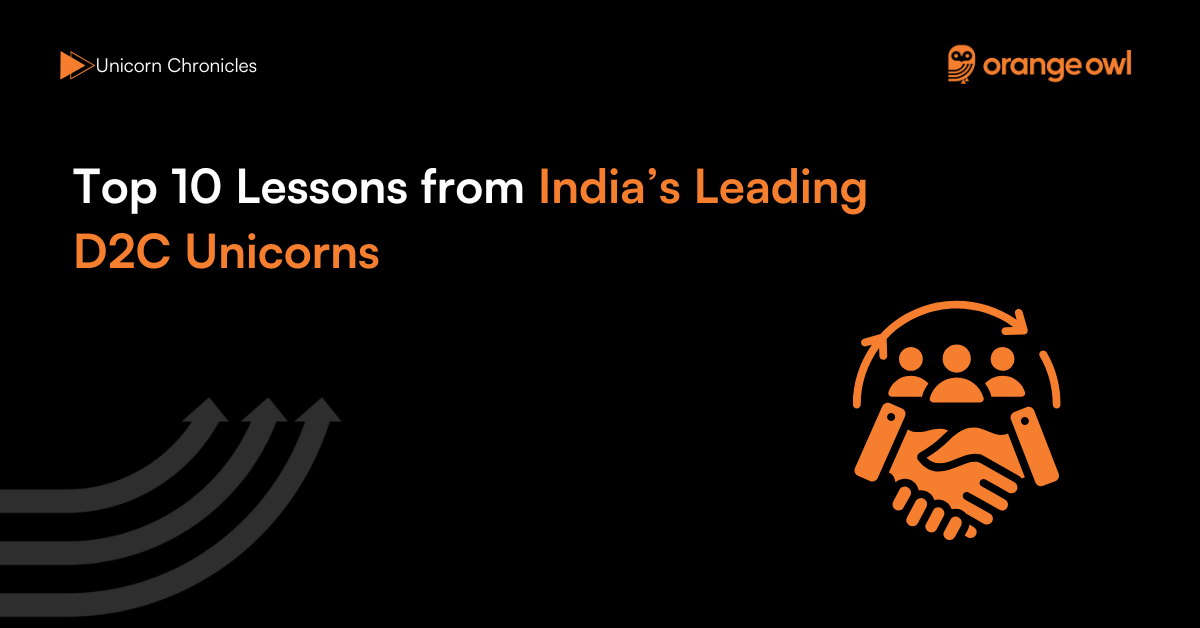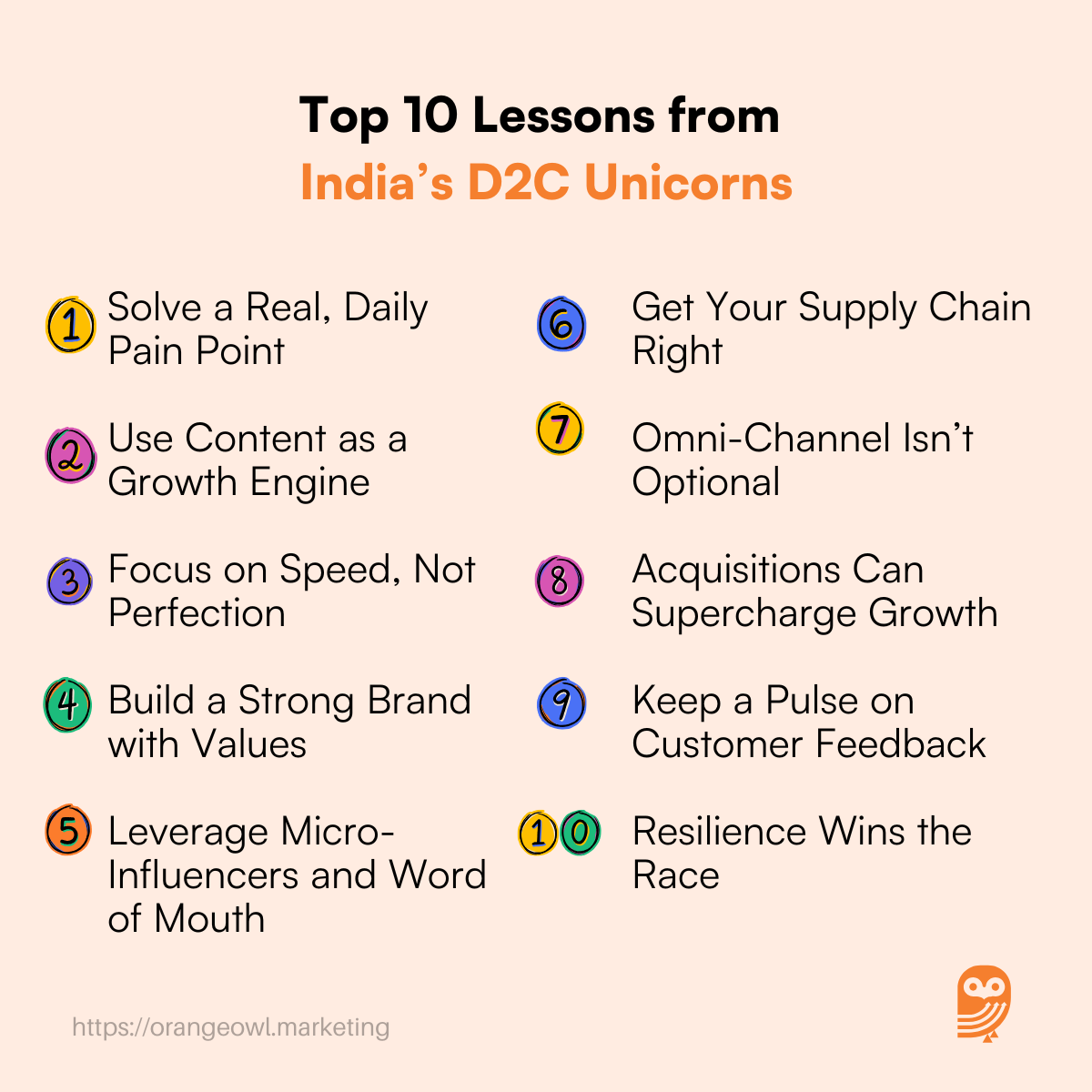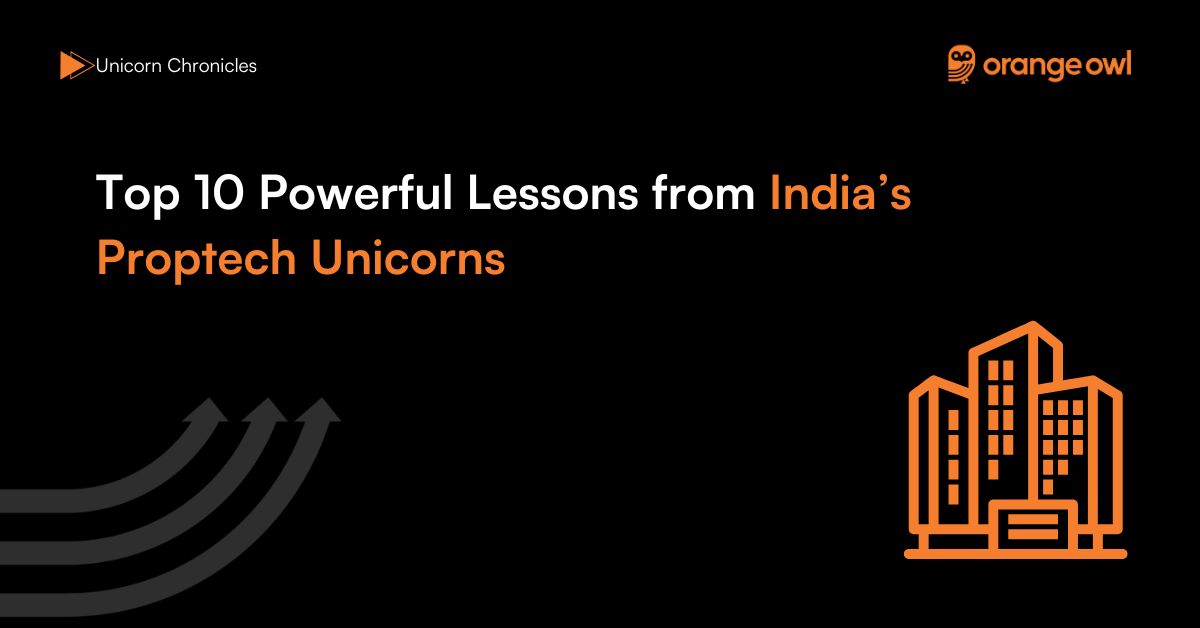Top 10 Lessons from India’s Leading D2C Unicorns
Vivek Goel
June 12, 2025

Table of Contents
Introduction
India’s Direct-to-Consumer (D2C) revolution has redefined the way brands connect with customers. Over the past decade, a new wave of startups has emerged, cutting out middlemen and building deep, direct relationships with consumers. These brands have not only disrupted traditional retail but also created powerful emotional connections by solving real, everyday problems with authenticity and innovation.
From toxin-free baby care to inclusive beauty and doorstep meat delivery, Indian D2C brands have shown that success lies in understanding the customer intimately and delivering unmatched value. At the forefront of this movement are three standout unicorns — Mamaearth, The Good Glamm Group, and Licious. Each of them has charted its own path to scale, navigating market challenges, building brand loyalty, and setting new benchmarks in customer experience.
We explored the journeys of these D2C pioneers :
- Mamaearth Success Story: 5 Insightful Lessons for Every Entrepreneur
- The Good Glamm Group Success Story: 5 Essential Lessons for Every Entrepreneur
- Licious Success Story: 5 Growth Lessons Every Entrepreneur Should Learn
These detailed stories offer not just inspiration but also practical playbooks for founders, marketers, and operators in the D2C space. Whether you’re building a brand from scratch or scaling one, there’s something to learn from each of their journeys.
We’ve consolidated the key insights from all three unicorns into a single list — The Top 10 Lessons Every Entrepreneur Can Learn from India’s Leading D2C Startups. These lessons span product strategy, marketing, branding, customer experience, and growth, offering a 360° view of what it takes to thrive in today’s competitive consumer market.
1. Solve a Real, Daily Pain Point
One of the most common traits among successful D2C startups is their ability to identify and solve a genuine, everyday consumer problem.
- Mamaearth was born out of a deeply personal need—its founders couldn’t find safe, toxin-free baby care products for their newborn. This real-world frustration led to the creation of India’s first ‘Made Safe Certified’ brand, with a strong focus on natural, eco-conscious personal care for the entire family.
- Licious noticed how millions of Indians faced inconsistent quality, unhygienic handling, and poor service in the meat-buying experience. By offering clean, traceable, and freshly delivered meat, it solved a problem that affected countless homes every week.
- The Good Glamm Group identified a massive opportunity in the intersection of content and commerce. Women across India were consuming beauty content online, but few platforms converted that interest into trusted product purchases. The company built a media-meets-commerce model that felt both organic and engaging.
✅ Lesson: Don’t just build a product. Start by solving a real pain point that your customers experience regularly. Businesses that focus on genuine problems always have a stronger foundation than those chasing trends or hype.
2. Use Content as a Growth Engine
In the digital age, content is more than just marketing—it’s a moat. And no one understood this better than The Good Glamm Group.
- Before even expanding its product lines, the company invested in acquiring media brands like POPxo, ScoopWhoop, and MissMalini, creating a content network with massive reach and engagement.
- This gave them unparalleled access to user data, intent signals, and trust—converting readers into shoppers became seamless.
- They weren’t just selling beauty products; they were shaping conversations, educating consumers, and driving purchase behavior through storytelling.
✅ Lesson: In D2C, content can become your most powerful acquisition and retention tool. Create content that educates, entertains, and connects—it will fuel long-term brand loyalty and drive conversions.
3. Focus on Speed, Not Perfection
Speed was a defining trait for all three D2C unicorns.
- Mamaearth launched products quickly, often co-creating with its community and refining based on live feedback. Rather than waiting for perfection, they iterated fast and got better with time.
- Licious didn’t wait to perfect its cold-chain logistics before launching—they started small, refined processes along the way, and scaled in stages.
- The Good Glamm Group rolled out new campaigns, products, and content series with agility, testing continuously to see what clicked.
✅ Lesson: In today’s fast-moving consumer landscape, speed wins. Launch quickly, learn from your customers, and adapt. Waiting for the “perfect” product often means missing the market altogether.
4. Leverage Micro-Influencers and Word of Mouth
Influencer marketing is often associated with celebrities, but these D2C brands proved the power of authentic micro-influencers and organic word-of-mouth.
- Mamaearth built early trust by working with mom bloggers and nano-influencers who genuinely resonated with the brand’s mission. Their endorsements felt personal and relatable.
- The Good Glamm Group turned content creators into ambassadors, enabling a two-way relationship between consumers and the brand.
- These strategies helped both brands penetrate Tier 2 and Tier 3 cities, where influencer recommendations were even more trusted than ads.
✅ Lesson: You don’t need big names to build buzz. Start with micro-influencers who speak directly to your target audience. Encourage word-of-mouth by creating a product people want to talk about.
5. Build a Strong Brand with Values
What made these brands stand out wasn’t just their products—it was their commitment to values that resonated with consumers:
- Mamaearth stood for safe, natural, and environmentally conscious parenting. Its promise of no toxins and sustainable practices created trust among young parents.
- The Good Glamm Group embraced inclusive, accessible, and empowering beauty. It catered to diverse skin tones, body types, and identities, breaking the mold of traditional beauty standards.
- Licious built its brand around trust, transparency, and hygiene—a bold promise in an unorganized meat sector where safety was a daily concern.
These weren’t just marketing slogans—they were deeply embedded in product design, packaging, customer service, and communication.
✅ Lesson: A strong D2C brand is more than just a logo and product. It’s a belief system. When your values align with your customers’, you don’t just sell—you build a community.

6. Get Your Supply Chain Right
In the D2C space, customer expectations are high—consistency, speed, and product integrity are non-negotiable. That’s why both Licious and Mamaearth chose to take control of their supply chains early in their journey.
- Licious made a bold move by investing heavily in cold-chain infrastructure, warehouses, and last-mile delivery to ensure that the meat was always fresh, safe, and delivered on time. This level of control became a huge differentiator in a market where hygiene standards were often questionable.
- Similarly, Mamaearth emphasized in-house R&D, formulation, and packaging. They didn’t just slap their label on white-label products—they built their own formulations aligned with their values of safety and toxin-free living.
✅ Lesson: In D2C, logistics and quality control are part of the brand experience. Don’t outsource the elements that define your product or your promise to the customer.
7. Omni-Channel Isn’t Optional
While all three brands started as digital-first, they quickly realized that true scale comes from being omnipresent—online and offline.
- Mamaearth made a strong retail push, getting their products on the shelves of beauty stores, pharmacies, and supermarkets, thereby expanding their reach to non-digital shoppers.
- Licious experimented with Experience Centers to enhance brand visibility and provide a tactile experience for customers.
- The Good Glamm Group, through strategic acquisitions and partnerships, entered salons, retail formats, and beauty counters, making their brands omnipresent.
✅ Lesson: D2C doesn’t mean digital-only. Go where your consumers shop—whether that’s Instagram or a neighborhood store. A strong omnichannel strategy amplifies reach and builds brand recall.
8. Acquisitions Can Supercharge Growth
Of the three, The Good Glamm Group stands out for pioneering a model where acquisitions were central to growth. They didn’t just scale organically—they built an ecosystem.
- Their acquisitions included MyGlamm (beauty products), POPxo and ScoopWhoop (media), and BabyChakra (parenting community), giving them access to content, audiences, and products all at once.
- Each acquisition brought a unique strength—eyeballs, distribution, or data—which, when combined, created a powerful content-to-commerce flywheel.
✅ Lesson: Growth doesn’t have to be built from scratch. Strategic M&A, when aligned with your brand’s vision, can accelerate growth, open new customer segments, and create defensibility.
9. Keep a Pulse on Customer Feedback
One of the most powerful levers in building a D2C brand is listening deeply to your customers. These unicorns didn’t just collect feedback—they used it to drive product innovation, UX improvements, and even content ideas.
- Mamaearth involved its community in product ideation and regularly tweaked formulas based on real-time input.
- Licious adjusted its delivery models, product cuts, and packaging in response to consumer expectations.
- The Good Glamm Group continuously fine-tuned its content strategy by studying engagement metrics, comments, and shopping behavior.
✅ Lesson: Your customers are speaking—through reviews, social comments, and purchase behavior. Listen. They’ll tell you exactly what to build, fix, or evolve next.
10. Resilience Wins the Race
It hasn’t been a smooth ride for any of these companies. They’ve weathered regulatory uncertainties, intense competition, funding crunches, and market skepticism—and yet, they’ve emerged stronger each time.
- Mamaearth faced scrutiny during its IPO phase but maintained focus and transparency.
- Licious scaled in a category where infrastructure was lacking and quality perception was low, requiring immense perseverance.
- The Good Glamm Group navigated integration challenges while acquiring multiple companies and building a unified brand.
What unified them all was resilience—an ability to pivot quickly, stay mission-driven, and never lose sight of their customer.
✅ Lesson: D2C journeys are marathons, not sprints. Stay agile, be ready to shift direction, and never underestimate the power of persistence.
Conclusion
India’s D2C wave has redefined how brands are built—from the ground up, with purpose, agility, and direct consumer engagement. The journeys of Mamaearth, The Good Glamm Group, and Licious prove that you don’t need a massive legacy to create massive impact.
What you do need is clarity of mission, obsession with customer experience, and the willingness to evolve with market demands.
These brands didn’t just sell products—they sold trust, values, and experiences. For any entrepreneur navigating the modern D2C landscape, their stories are a powerful reminder: Build for the customer, stay resilient, and never stop innovating.
The next big D2C brand could be yours—and the lessons are already out there.


